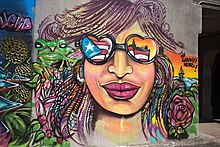Coquí
| Coquí (Puerto Rican frog) | |
|---|---|

| |
| Common coquí, Eleutherodactylus coqui | |
| Scientific classification | |
| Kingdom: | |
| Phylum: | |
| Class: | |
| Order: | |
| Family: | |
| Genus: | Duméril and Bibron, 1841
|
| Species | |
| |
Coquí is the common name for several species of small frogs in the Eleutherodactylus genus that are native to Puerto Rico. They are onomatopoeically named for the very loud mating call which the males of two species, the common coquí and the mountain coquí, make at night. The coquí is one of the most common frogs in Puerto Rico with more than 16 different species found within its territory, including 13 in the El Yunque National Forest. Other species of this genus can be found in the rest of the Caribbean and elsewhere in the Neotropics, in Central and South America. All species of Eleutherodactylus are characterized by direct development in which eggs hatch into small frogs, the tadpole stage being passed in the egg itself.
Taxonomy
Coquíes belong to the Eleutherodactylus genus which in Greek means free toes. Eleutherodactylus contains over 700 different species that naturally occur in the southern United States, Central America, South America, and the Caribbean. Coquíes additionally have become established in Hawaii, where they are considered an invasive species.
Seventeen described species of coquíes inhabit Puerto Rico. In 2007, a new species, the coquí llanero, was officially named Eleutherodactylus juanariveroi.[1]
Role in the ecosystem
The various species of coquí control the populations of herbivorous insect species in their local environments.
Population decline
The decline of coquí populations has accelerated since the introduction of the Batrachochytrium dendrobatidis fungus.[2] This pathogenic fungus has been extremely devastating towards amphibian populations as the pathogen impairs the permeability of the skin. The coquíes found in El Yunque are resistant to the B. dendrobatidis fungus at the expense of their size, which reduces the aptitude to survive in the wilderness (Burrowes, Longo and Rodríguez 2007). Individuals that carry this fungus resistance are more often found where the B. dendrobatidis fungus is concentrated. Although the fungus prefers humid environments, infection is more frequent in drier climates because coquíes tend to cluster in humid sub-areas within this drier climate, thereby increasing the chance of spreading of the pathogen.[2]
Geographic distribution
The current record from the USGS[3] establishes that it has been identified in Puerto Rico, Hawaii, St. Croix, St. John, St. Thomas, and the Dominican Republic.
Coquíes have become established in the Big Island of Hawai'i, where they are considered an invasive species. Coquí population density in Hawaii can reach 20,000 animals per acre and affects 50,000 acres (20,000 ha). Eradication campaigns are underway on Hawaiʻi and Maui.[4][5][6] Some groups favor its adoption.[clarification needed][7]
Eradication techniques include hand capture and spraying with a 12% solution of citric acid along with a certification program for nurseries to prevent them from acting as centers of contagion.[4]
In popular culture

Puerto Rican boy band Menudo had a song named "Coqui",[8] which they sang on their movie Una Aventura Llamada Menudo, on a scene where coquis can be heard. you can hear the sound of a coquí in the song "Todo me recuerda a ti" by Pedro Capó.[citation needed]
The sound of a coquí can be heard distinctly at the beginning and end of the songs "Acércate" and "Ángel Caído",[9] by singer Ivy Queen.
In the first movement of The Mars Volta's song "Miranda That Ghost Just Isn't Holy Anymore", 4 minutes of coquí frogs can be heard singing (credited as "The Coquí of Puerto Rico" on the album sleeve).[10]
The sounds of coquí can be heard in various night scenes in The Rum Diary (2011) starring Johnny Depp and Aaron Eckhart and filmed in Puerto Rico.
See also
- Common coquí
- Fauna of Puerto Rico
- List of amphibians and reptiles of Puerto Rico
- Coqui francolin, also onomatopoeically named
References
- ^ Ríos-López, N. and R. Thomas. 2007. A new species of palustrine Eleutherodactylus (Anura: Leptodactylidae) from Puerto Rico. Zootaxa 1512: 51–64
- ^ a b Burrowes, Patricia A. and Ana V. Longo. Persistence with Chytridiomycosis Does Not Assure Survival of Direct-developing Frogs. EcoHealth June 2010: p.185-195. ProQuest. Web. 5 June 2011.
- ^ "Coqui (Eleutherodactylus coqui) - FactSheet". Nas.er.usgs.gov. Retrieved 2012-06-13.
- ^ a b Shafer, Jacob (November 18, 2010). "On the Front Lines of the Coqui Battle With Maui Invasive Species Committee". Retrieved November 2010.
{{cite web}}: Check date values in:|accessdate=(help) - ^ "Control of Coqui Frog in Hawai'i". Ctahr.hawaii.edu. Retrieved 2012-06-13.
- ^ Philip A. Thomas (2009-01-27). "Coqui & greenhouse frogs: alien Caribbean frogs in Hawaii". Hear.org. Retrieved 2012-06-13.
- ^ "Hawaiian Coqui, Facts about the coqui in Hawai'i". Hawaiiancoqui.org. Retrieved 2012-06-13.
- ^ http://www.songlyrics.com/menudo/coqui-lyrics/
- ^ Real (CD liner). Ivy Queen. Perfect Image Records Inc. Manufactured and distributed by Universal Music Latino, 420 Lincoln Rd. Suite 200, Miami Beach, FL 33139, through Universal Music & Video Distribution. 2004. 809507157-2.
{{cite AV media notes}}: Unknown parameter|titlelink=ignored (|title-link=suggested) (help)CS1 maint: others in cite AV media (notes) (link) - ^ Frances The Mute (CD Liner). The Mars Volta. Universal Records, Gold Standard Laboratories, and Strummer Recordings. 2005. B0004129-02, B0004129-02, B0004129-02.
{{cite AV media notes}}: Unknown parameter|titlelink=ignored (|title-link=suggested) (help)CS1 maint: others in cite AV media (notes) (link)

